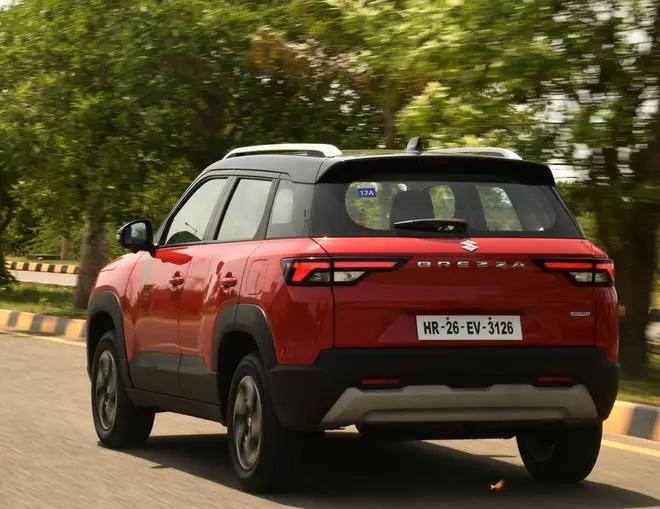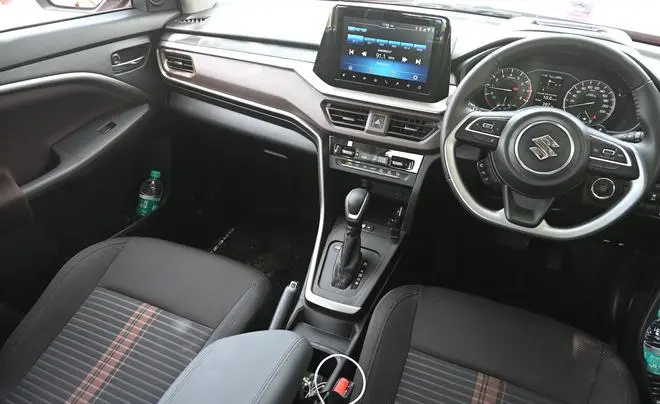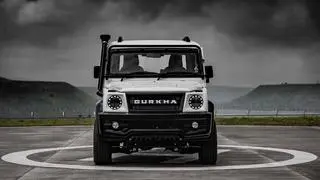The Vitara Brezza has been a key model in Maruti Suzuki’s portfolio. It has ridden the wave of demand in the sub-compact sports utility vehicle segment, and has quite literally been the only SUV in the company’s “hatch-heavy” portfolio. For buyers that have been seeking the body style, its attributes, and advantages, the Vitara Brezza has been a good choice.
Six years since it was first introduced, the Vitara Brezza gets a proper makeover. And there is a lot that’s new, including a shortened name and a new heart. With the upcoming compact SUV that will also be a shared platform with Toyota for a similar vehicle, the Vitara Brezza will hereon be referred to simply as the Brezza. And buzzing inside the bonnet is the more refined next-gen K Series engine. Does the new Brezza then take the game to the next level? How does it compare with its competitors?
Design

Both the manual and auto gearbox versions of the Brezza get the mild hybrid and start/ stop systems, adding to the improved efficiency of the powertrain | Photo Credit: BIJOY GHOSH
The changes to the exterior design of the new Brezza are quite extensive. The entire body-in-white (BIW) is new; needed both for aesthetic reasons, as also for accommodating the key addition of six airbags as a safety feature. With the entire top shell being new, all the body panels are also new with absolutely no carry over from the previous model. The general design of the Brezza remains familiar and sort of carries forward the language of the predecessor, but it is obvious that it has added a layer of lean muscle all around. It also seems to stand a bit taller; an impression that is created by the 30mm higher bonnet line for the Brezza. Despite the visual cues, it was surprising to note that except for a 45mm increase in height, the other dimensions are the same as the previous model. The track also hasn’t increased. In fact, most of the chassis and suspension geometry remains the same, though the materials used in the case of the chassis and tuning in the case of the suspension have been changed. However, Maruti officials did emphasise that this is a new generation for the model based on the ‘TECT’ platform. The new Brezza’s design is still boxy, but it gets a few softer edges. There are also those hints of a design language that is now shared with other models, like the tail-lamps, which seem to share lines with the new Baleno. With more LED light elements and a mix of metallic trim elements, the exterior design of the new Brezza is also more “techy” than the previous model.
The front grille and headlamps are a particularly good example of this improvement. Finer aspects that point to an improvement in design and production quality can be seen in the way the bonnet slab now curls and overbites at the edge. The contrast black body side cladding now features squared-off wheel arches and a new set of 16-inch ‘geometric’ alloy wheels. The alloys now sport 215/60 R16 tyres. The rear design of the Brezza is where more changes can be seen.
The tail-lamps, with their elongated inward edges, add to the sense of width and stance. The Brezza also gets larger and more prominent skid plates at the front and rear, so the dual-tone fenders are all new too. There are a couple of new body paint colours and the option of dual tone finishes (contrast roof) to choose from now.
Cabin

Brezza cabin also gets features like ambient lighting, Arkamys tuned sound system, auto headlamps and wireless phone charger with overheating protection | Photo Credit: Bijoy Ghosh
The Brezza’s interior definitely looks refreshed and like an upgrade to the outgoing model. The space inside the cabin is the same as the previous one in terms of shoulder room and head room. Legroom too remains mostly the same, except for the front passenger, who will now benefit from a more compact, vertical dashboard section that liberates about 40mm of extra kneeroom.
The fact that space in the rest of the cabin remains the same is still not an issue because the Vitara Brezza and the new model still offer one of the most spacious cabins in the sub-compact class. The seats are new, featuring a different construction and woven fabric upholstery. They offer good lumbar and thigh support, even in the rear bench seat the squabs are a tad soft. One of the customisation packs offers faux leather seat covers, which may make them feel firmer.
The dashboard in the Brezza sports a layered design with new textured panels that offer some relief from the over-plasticky feeling of the average Maruti hatch. My test mule sported a dual-tone, black and chocolate brown colour theme with faux aluminium trim inserts. It also (finally) gets some cushioned fabric sections on the door panels, making the cabin feel much less tacky.
The overall cabin finish quality is now on par with NEXA models. The key additions to the cabin that make the Brezza more loaded with tech are features like the head-up display and the new, larger 9-inch infotainment screen. The HUD is from the Baleno, with its multi-colour display, throwing quite a clutch of driving info onto the transparent screen in the line of sight of the driver. The execution of the HUD is good, though it does seem a bit functional in the way it deploys.
The infotainment screen is embedded with the latest generation of SmartPlay Pro+ UI and also displays a 360-degree parking view from the output of three cameras mounted at the rear and the two door mirrors.
There is also a set of voice commands and more than 40 connected car features on offer using Suzuki Connect. The instrument cluster is also a wider, more suave looking unit with larger analog dials and a multiple-information display in the middle delivering key info like real-time efficiency, distance-to-empty etc. The steering wheel in my top-trim test mule was a leather-wrapped, flat-bottomed unit with controls for cruise control and infotainment functions. I was driving the auto transmission version and it is good to see it get paddle-shifters for manual gear selection, after they were first offered in the new XL6. The Brezza’s boot offers about 328-litres of luggage space.
Performance
The Brezza gets the new gen K series (K15C) 1.5-litre petrol engine. There is a choice of a 6-speed automatic transmission and a 5-speed manual gearbox with this engine. The 1,462cc mill generates a peak power of about 102hp and a peak torque of about 137Nm. The output levels a just a shade lower than the previous gen K15B engine. But thanks to a dual-injector setup (compared to the single in the previous gen), this engine is more efficient and refined. Mileage delivered is now a claimed 20.15kmpl, almost three kmpl, more than the previous gen. Some of the improvement possibly comes from the way power is delivered in metered quantities. Tuning and throttle mapping seems have been optimised for efficiency too. So, while the Brezza doesn’t feel underpowered, it doesn’t feel peppy either.
There are no complaints about its low speed performance, with enough torque and power avaialble even at low to mid-rpm levels. But delayed response, a bit of lazy power delivery and a noisier cabin are the outcome under hard acceleration. That said, like in the case of the Baleno, the real improvement in powertrain refinement is evident under normal driving conditions. That includes a quiet cabin which is well-insulated even from road noise.
The Brezza’s new 6-speed torque converter automatic is also a good match compared to the previous model’s 4-speed auto. There is a ‘M’ manual mode that holds the gear selected via the paddles all the way to the rev-limiter. Unfortunately though since it is the last slot in gear stick selector, it will take a bit of getting used to (same issue with the XL6). Maruti engineers could’ve just let the paddle selection be an option in drive ‘D’ mode.
The manual gearbox version features a light clutch and clean shifts with a short-throw stick. The ride quality is typically Maruti; with a comfort bias.
But the setup ensures good high-speed stability and decent control into corners, though there is mild body roll.
Both the manual and auto gearbox versions of the Brezza get the mild hybrid and start/ stop systems, adding to the improved efficiency of the powertrain.
Bottom Line
The new Brezza is designed and kitted out better than the previous model. All those new features in the cabin should help it take on the competitors in the segment.
Some of the new equipment like the sunroof have been driven by customer feedback. It is also a good move to make it safer (than the predecessor) with the addition of six airbags, at least for the top trim variants. The choice of powertrain seems to have been made with an eye on the future and the tuning is focused on getting the most mileage out of it.
But the shift to an engine that is bigger than a 1.2-litre means that the Brezza will not get the lower duty benefits that its predecessor enjoyed.
The new price range of ₹7.99 lakh to ₹13.96 lakh is a reflection of that change. It will still be the choice for a whole new range of buyers.







Comments
Comments have to be in English, and in full sentences. They cannot be abusive or personal. Please abide by our community guidelines for posting your comments.
We have migrated to a new commenting platform. If you are already a registered user of TheHindu Businessline and logged in, you may continue to engage with our articles. If you do not have an account please register and login to post comments. Users can access their older comments by logging into their accounts on Vuukle.